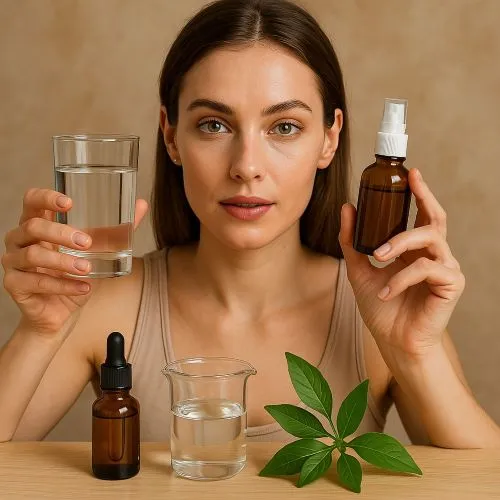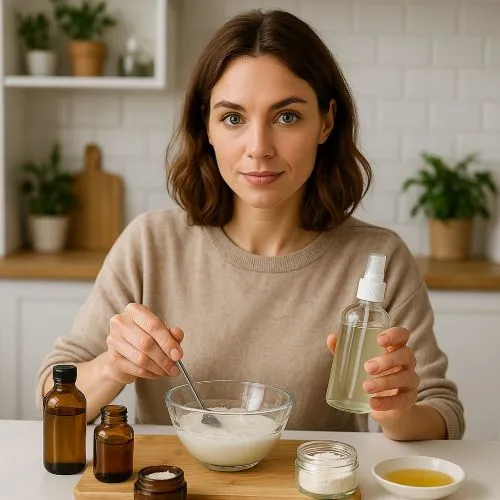-
 DIY: Video master classes
DIY: Video master classes
-
 Aromatherapy
Aromatherapy
-
 Felting master classes
Felting master classes
-
 Eating at home
Eating at home
-
 DIY cosmetics for children
DIY cosmetics for children
-
 Cooking recipes
Cooking recipes
-
 Detergents, cleaning products with your own hands
Detergents, cleaning products with your own hands
-
 Soap making as a business
Soap making as a business
-
 Natural cosmetics. Raw materials for cosmetics and soap.
Natural cosmetics. Raw materials for cosmetics and soap.
-
 Natural oils in cosmetics
Natural oils in cosmetics
-
 News
News
-
 Recipes for balms and conditioners
Recipes for balms and conditioners
-
 Bath Bomb Recipes
Bath Bomb Recipes
-
 Cream recipes. Cream making.
Cream recipes. Cream making.
-
 Lotion recipes. Gel recipes.
Lotion recipes. Gel recipes.
-
 Mask recipes
Mask recipes
-
 Soap recipes. Base soap. Soap from scratch.
Soap recipes. Base soap. Soap from scratch.
-
 Recipes for all occasions
Recipes for all occasions
-
 Natural shampoo recipes
Natural shampoo recipes
-
 Healthy Nutrition Recipes
Healthy Nutrition Recipes
-
 Scrub recipes. Massage tiles. Ubtan
Scrub recipes. Massage tiles. Ubtan
-
 DIY candles
DIY candles
-
 Reference materials, questions, tips
Reference materials, questions, tips
-
 Startup - soap production
Startup - soap production
-
 Hair care. Tips, recipes
Hair care. Tips, recipes
-
 Facial skin care. Cleansers.
Facial skin care. Cleansers.
-
 Body care. Tips, recipes
Body care. Tips, recipes
-
 Photo Reviews
Photo Reviews
-
 Chocolate Handmade
Chocolate Handmade
Why you can't replace water with hydrolate in a cosmetic recipe - and how to use it correctly
 In the world of DIY cosmetics, hydrolates, or floral waters, are incredibly popular for their unique properties and delightful aromas. They often seem like the perfect substitute for plain water in any recipe, promising to infuse your products with extra beneficial qualities. However, a direct and unthinking swap of distilled water for a hydrolate can lead to unexpected, and sometimes undesirable, outcomes. Understanding the fundamental differences between water and hydrolates is crucial for creating stable, effective, and safe homemade cosmetic products.
In the world of DIY cosmetics, hydrolates, or floral waters, are incredibly popular for their unique properties and delightful aromas. They often seem like the perfect substitute for plain water in any recipe, promising to infuse your products with extra beneficial qualities. However, a direct and unthinking swap of distilled water for a hydrolate can lead to unexpected, and sometimes undesirable, outcomes. Understanding the fundamental differences between water and hydrolates is crucial for creating stable, effective, and safe homemade cosmetic products.
In this comprehensive guide, we'll dive deep into why a hydrolate isn't always a direct replacement for water, what its unique properties are, and how to properly incorporate it into your recipes to reap maximum benefits. We'll also explore the advantages of intelligently using hydrolates compared to industrial counterparts and provide three detailed recipes where hydrolates are used with all the nuances in mind.
Water vs. Hydrolate: Key Differences
At first glance, both water and hydrolates appear as clear liquids. Yet, their nature and chemical composition differ significantly:
- Water (Distilled/Purified): This is the purest form of water, stripped of minerals, salts, bacteria, and other impurities. It provides a stable base for cosmetic recipes because it lacks components that might react with other ingredients or promote microbial growth. Its pH is typically neutral (around 7).
- Hydrolate (Floral Water, Aromatic Water): This is a co-product of the steam distillation of plants for essential oils. A hydrolate contains water-soluble plant components, trace amounts of essential oils (up to 0.5%), and organic acids. This makes it an active ingredient with a specific pH (often acidic, around 4.0-6.0), a unique aroma, and specific therapeutic properties (e.g., moisturizing, soothing, antibacterial).
The presence of active components and a variable pH is precisely why a hydrolate can't always replace water:
- Instability: The organic substances in a hydrolate make it less stable and more prone to bacterial and fungal growth compared to distilled water. This necessitates the use of stronger preservatives or a shorter shelf life.
- Variable pH: The acidic or neutral pH of a hydrolate can affect the overall pH of the final cosmetic product and the stability of other ingredients (e.g., emulsifiers that are pH-sensitive).
- Ingredient Interactions: Some components in a hydrolate might react unfavorably with other active ingredients in the recipe, reducing their effectiveness or altering the product's properties.
Advantages of Smart Hydrolate Use in Homemade Cosmetics
Despite the limitations, hydrolates are a valuable asset in homemade cosmetics when used correctly. Their advantages over industrial products (which often contain artificial fragrances and minimal concentrations of plant extracts) are clear:
- Natural Plant Properties: Hydrolates retain many therapeutic properties of their source plant (e.g., soothing properties of chamomile, balancing properties of witch hazel, moisturizing properties of rose).
- Gentle Impact: They are milder than essential oils, making them safe for sensitive skin without causing irritation.
- Natural Aroma: They impart a pleasant, light, natural fragrance to products without synthetic additives.
- Hydration & Toning: Excellent for hydrating the skin, preparing it for subsequent care, and serving as superb toners.
- Safety & Control: You choose high-quality hydrolates and know exactly what you're adding to your product, avoiding harmful impurities.
How to Correctly Use Hydrolates in Cosmetic Recipes
To get the most out of hydrolates and ensure product stability, follow these guidelines:
- As Part of the Water Phase: Hydrolates can replace a *portion* of the distilled water in a recipe (e.g., 20-50% of the total water phase). This allows you to add the hydrolate's properties without compromising stability.
- As a Toner or Spray: This is the simplest and safest way to use a hydrolate. You can mist it onto your face after cleansing, as a refreshing spray throughout the day, or to set makeup. In this case, always use a preservative.
- In Masks and Ubtans: Use a hydrolate to reconstitute dry masks or ubtans just before application.
- With a Preservative: Any water-based solution that won't be used immediately requires a broad-spectrum cosmetic preservative, even if it's 100% hydrolate. Hydrolates contain organic matter, which is a breeding ground for bacteria.
- pH Control: If the hydrolate has a significantly different pH than what you need for the recipe (especially for emulsions), be prepared to adjust the pH of the final product.
- Hydrolate Quality: Only use high-quality, pure hydrolates without additives, obtained through steam distillation.
Three Detailed Recipes with Correct Hydrolate Use
The following recipes demonstrate how to integrate hydrolates into different types of cosmetic products, leveraging their beneficial properties without sacrificing stability.
Recipe #1: Soothing Facial Toner with Chamomile Hydrolate
This toner is ideal for sensitive and irritated skin, helping to reduce redness and hydrate.
Ingredients:
- Chamomile Hydrolate: 90 ml
- Vegetable Glycerin: 5 ml
- Panthenol (D-Panthenol): 3 ml
- Cosmetic Preservative (e.g., Cosgard): 2 ml (or according to manufacturer's instructions)
Preparation:
- Preparation: Sanitize all tools and the bottle.
- Mixing: In a clean glass beaker, combine the chamomile hydrolate, glycerin, and panthenol. Stir until fully dissolved.
- Adding Preservative: Add the cosmetic preservative and stir thoroughly but gently, trying not to create too much foam.
- Transfer: Pour the finished toner into a sanitized spray bottle.
Recipe #2: Hydrating Face Cream with Rose Hydrolate (Emulsion)
This cream combines the moisturizing properties of rose hydrolate with nourishing oils. Note that the hydrolate makes up only a portion of the water phase.
Ingredients:
- **Water Phase:**
- Distilled Water: 35 ml
- Rose Hydrolate: 25 ml
- Glycerin: 5 ml
- **Oil Phase:**
- Emulsifier (e.g., Olivem 1000): 5 g
- Jojoba Oil: 10 ml
- Rosehip Oil: 5 ml
- Shea Butter: 5 g
- **Cool Down Phase (added after emulsification):**
- Vitamin E (Tocopherol): 1 ml
- Cosmetic Preservative (e.g., Euxyl PE 9010): 1 ml (or according to instructions)
- Essential Oil (Rose or Geranium): 3-5 drops (optional)
Preparation:
- Preparation: Sanitize all tools and beakers. Separate the water and oil phases into two separate heat-resistant beakers.
- Heating Phases: Place both beakers in a water bath. Heat both phases separately until the emulsifier and oils in the oil phase are fully melted and both phases reach a consistent temperature (around 70-75°C / 158-167°F).
- Emulsification: Remove both beakers from the water bath. Slowly pour the water phase into the oil phase while continuously stirring with a mini-mixer or whisk for 3-5 minutes until a stable emulsion forms.
- Cooling and Adding Actives: Continue stirring the emulsion until it cools to around 35-40°C (95-104°F). Add Vitamin E, the preservative, and essential oils. Stir thoroughly.
- pH Check: If necessary, adjust the cream's pH to 5.0-5.5 using a few drops of lactic acid.
- Transfer: Pour the finished cream into a sanitized jar.
Recipe #3: Refreshing Hair and Body Spray with Peppermint Hydrolate
A light spray that's great for refreshing during summer and for light hydration.
Ingredients:
- Peppermint Hydrolate: 95 ml
- Humectant/Active (e.g., NMF complex or Aloe Vera gel): 3 ml
- Cosmetic Preservative (e.g., Geogard 221): 2 ml (or according to manufacturer's instructions)
- Optional: Peppermint Essential Oil: 1-2 drops (to enhance aroma, but use cautiously!)
Preparation:
- Preparation: Sanitize the spray bottle.
- Mixing: In a clean beaker, combine the peppermint hydrolate, humectant/active, and preservative. Mix well.
- Adding Essential Oil (optional): If using, add 1-2 drops of peppermint essential oil and mix again.
- Transfer: Pour the finished spray into the prepared bottle.
Recommendations for Use and Storage
Application:
- Toners and Sprays: Apply to clean face and body, or hair. Use daily, morning and evening, or as needed.
- Creams and Lotions: Apply as intended by the recipe – to clean face and/or body.
- Patch Test: Always perform a patch test on a small skin area before full use of a new product, especially if you have sensitive skin.

Storage:
- Cool, Dark Place: Store all products containing hydrolates in a cool, dark place, away from direct sunlight and heat sources.
- Airtight Packaging: Always use airtight packaging to prevent evaporation and contamination.
- Shelf Life: Even with a preservative, the shelf life of cosmetics containing hydrolates is typically 1 to 3 months. Without a preservative, pure hydrolates only last 1-2 weeks in the refrigerator, and even less in recipes. Always closely monitor for changes in scent, color, or consistency – if any signs of spoilage are detected, the product should be discarded.
Hydrolates are a true gift from nature for skin care, capable of boosting the effectiveness of your cosmetic products. However, to fully unlock their potential, it's crucial to understand their unique characteristics and integrate them into your recipes intelligently. By following these recommendations, you can create not only effective but also safe, high-quality homemade cosmetics that truly care for your skin.
Mylo Opt Cosmetics Blog – Your Reliable Guide to Beauty and Care
Welcome to the Mylo Opt cosmetics blog! Here, you will find valuable advice, interesting recipes, and professional recommendations for creating soap, cosmetics, and candles with your own hands. Our blog is designed for anyone passionate about natural cosmetics, looking for new ideas, and wanting to learn more about producing high-quality skincare and haircare products. We share tested recipes, useful tips, and the latest news from the world of cosmetics.
Why Choose the Mylo Opt Cosmetics Blog?
Mylo Opt is not just an online store; it is a community of people passionate about creating natural cosmetics. Here are a few reasons why our blog will be useful to you:
- Experience and Expertise: Our authors are experienced cosmetologists, soap makers, and aromatherapy specialists. We share reliable and tested recipes that have undergone thorough testing and received positive feedback.
- Credibility and Authority: We ensure that all information in our blog is up-to-date and reliable. We reference scientific research and verified sources so that you can trust the quality of the information provided.
- Reader-Focused: Our content is tailored to you – our readers. We strive to answer your questions, solve your problems, and inspire new achievements in the world of natural cosmetics.
Popular Products from the Mylo Opt Online Store
Before we move on to recipes and tips, let us introduce you to the most popular products from our online store, which will help you create high-quality and natural cosmetics:
- Soap Bases: High-quality soap bases allow you to create beautiful and beneficial handmade soaps. We offer glycerin bases, bases with added oils and extracts, as well as transparent and white bases.
- Fragrance Oils and Fragrances: Give your products a unique scent with our fragrance oils and fragrances. We offer a wide range of scents – from fresh and floral to spicy and woody.
- Essential Oils: Essential oils are natural components that not only add fragrance to products but also offer beneficial properties for the skin and hair. Our range includes lavender, mint, eucalyptus, lemon, and many other oils.
- Active Ingredients: Vitamins, antioxidants, hyaluronic acid, and other active ingredients help improve the properties of your cosmetics. We offer only tested and high-quality components.
- Pigments and Dyes: Give your products bright and lasting colors with our pigments and dyes. They are safe for the skin and suitable for use in soap, cosmetics, and candles.
- Emulsifiers and Thickeners: To create creams and lotions, you will need emulsifiers and thickeners. We offer quality ingredients that help you achieve the desired consistency and stability of the product.
- Soap and Candle Molds: Create unique items with our soap and candle molds. Our range includes molds of various sizes and designs.
- Everything for Candles: Wax, wicks, fragrances, and dyes for candles – we have everything you need to create beautiful and fragrant candles.
Recipes and Tips for Making Handmade Soap
Cold Process Soap for Beginners
Making cold process soap is an exciting process that allows you to control all the ingredients and create unique recipes. Here is one simple cold process soap recipe for beginners:
Ingredients:
- 500 g olive oil
- 300 g coconut oil
- 200 g palm oil
- 150 g castor oil
- 120 g lye (sodium hydroxide)
- 300 ml distilled water
- Essential oils (lavender, mint, eucalyptus)
- Pigments or natural dyes (optional)
Process:
- Prepare all ingredients and tools. Always use protective gloves and goggles, as lye can be dangerous.
- Weigh the lye and water. Slowly add the lye to the water, stirring until it fully dissolves. Allow the mixture to cool to 40-45°C.
- Weigh the oils and melt them in a water bath. When the oils and lye solution reach the same temperature (about 40-45°C), slowly pour the lye into the oils, stirring constantly.
- Use an immersion blender to mix until trace (when the mixture thickens and leaves a trail when stirred).
- Add essential oils and pigments if desired. Mix thoroughly.
- Pour the mixture into a prepared mold and cover with a towel. Let the soap harden for 24-48 hours.
- Remove the soap from the mold and cut it into bars. Allow the soap to cure for 4-6 weeks before use.
Homemade Cosmetics Recipes
DIY Moisturizing Cream
Creating a moisturizing cream at home allows you to control the ingredients and adapt the recipe to your needs. Here is a simple recipe for a moisturizing cream:
Ingredients:
- 50 ml rose water
- 50 ml distilled water
- 10 g emulsifier (e.g., Olivem 1000)
- 10 ml jojoba oil
- 5 ml avocado oil
- 5 drops lavender essential oil
- 2 drops tea tree essential oil
Process:
- Weigh all the ingredients.
- In a water bath, melt the emulsifier with the oils until smooth.
- Separately, heat the water phase (rose water and distilled water) to the same temperature as the oil phase.
- Slowly pour the water phase into the oil phase, stirring constantly.
- Use an immersion blender to emulsify until you achieve a creamy consistency.
- Add essential oils and mix thoroughly.
- Pour the cream into a sterilized jar and allow it to cool.
DIY Candle Recipes
Aromatic Soy Candle
Creating aromatic candles is a creative process that allows you to experiment with scents and designs. Here is a simple recipe for a soy candle:
Ingredients:
- 200 g soy wax
- 20 ml fragrance oil (e.g., vanilla or lavender)
- Wick for candles
- Dyes (optional)
- Glass or metal candle mold
Process:
- Melt the soy wax in a water bath until liquid.
- Add the fragrance oil and dyes if desired. Mix thoroughly.
- Secure the wick in the center of the candle mold.
- Slowly pour the melted wax into the mold, holding the wick.
- Allow the candle to fully harden (about 24 hours).
- Trim the wick to the desired length and enjoy your aromatic candle.
Tips for Beginners in Cream Making
- Learn the Basics: Before starting to create creams, it is important to learn the basic principles and ingredients used in cream making.
- Experiment with Formulas: Do not be afraid to experiment with different ingredients and proportions to find the perfect formula for your skin.
- Use Quality Ingredients: The effectiveness and safety of your product depend on the quality of the ingredients. Always choose tested and natural components.
- Maintain Hygiene: It is important to maintain cleanliness and sterility when creating cosmetics to avoid contamination and spoilage of the product.
- Start with Simple Recipes: For beginners, it is best to start with simple recipes to master the basic techniques and principles of cream making.
Conclusion
Our Mylo Opt cosmetics blog is your reliable source of information and inspiration in the world of natural cosmetics. We share useful tips, tested recipes, and the latest news to help you create quality and effective products for skin, hair, and home care. Subscribe to our blog, follow the updates, and discover new opportunities in the world of natural cosmetics with Mylo Opt!





